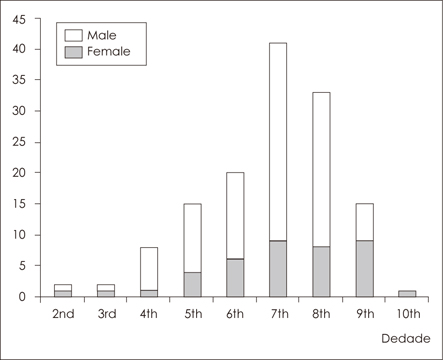J Korean Neurotraumatol Soc.
2011 Oct;7(2):83-87. 10.13004/jknts.2011.7.2.83.
Age-Specific Characteristics in Chronic Subdural Hematoma Patients
- Affiliations
-
- 1Department of Neurosurgery, Guro Hospital, Korea University College of Medicine, Seoul, Korea. jhkimns@gmail.com
- KMID: 2019919
- DOI: http://doi.org/10.13004/jknts.2011.7.2.83
Abstract
OBJECTIVE
It is well known that chronic subdural hematoma (CSDH) is relatively common in geriatric patients. However, frequently, CSDH can also develop in younger patients. We hypothesized that some clinical features may be different according to the age groups.
METHODS
Total one-hundred thirty seven surgically treated CSDH patients from January 2006 to April 2011 were included. We divided patients into three sub-group by age (young, average and old). We investigated several risk factors, preoperative and postoperative CT findings of each groups.
RESULTS
Hypertension, head trauma, arachnoid cyst and spontaneous intracranial hypotension were significantly associated with young age group compared to other groups. The recurrence rate of CSDH was higher in old age group with preoperative high density hematoma and postoperative pneumocephalus.
CONCLUSION
In this study, intracranial underlying diseases were relatively common in young age group. Old age group showed higher incidence of recurrence, preoperative mixed density and postoperative pneumocephalus on CT.
MeSH Terms
Figure
Cited by 1 articles
-
Burr Hole Drainage versus Small Craniotomy of Chronic Subdural Hematomas
Yong Woo Shim, Won Hee Lee, Keun Soo Lee, Sung Tae Kim, Sung Hwa Paeng, Se Young Pyo
Korean J Neurotrauma. 2019;15(2):110-116. doi: 10.13004/kjnt.2019.15.e25.
Reference
-
1. Adhiyaman V, Asghar M, Ganeshram KN, Bhowmick BK. Chronic subdural haematoma in the elderly. Postgrad Med J. 2002; 78:71–75.2. Baechli H, Nordmann A, Bucher HC, Gratzl O. Demographics and prevalent risk factors of chronic subdural haematoma: results of a large single-center cohort study. Neurosurg Rev. 2004; 27:263–266.
Article3. Domenicucci M, Russo N, Giugni E, Pierallini A. Relationship between supratentorial arachnoid cyst and chronic subdural hematoma: neuroradiological evidence and surgical treatment. J Neurosurg. 2009; 110:1250–1255.
Article4. Ferrante E, Arpino I, Citterio A, Wetzl R, Savino A. Epidural blood patch in Trendelenburg position pre-medicated with acetazolamide to treat spontaneous intracranial hypotension. Eur J Neurol. 2010; 17:715–719.
Article5. Hishikawa T, Chikama M, Tsuboi M, Yabuno N. [Two cases of symptomatic arachnoid cysts in elderly patients--a comparison and analysis with child cases]. No Shinkei Geka. 2002; 30:959–965.6. Jolobe OM. Chronic subdural haematoma in the elderly. J R Soc Med. 2002; 95:427–428.
Article7. Kajs-Wyllie M. Antihypertensive treatment for the neurological patient: a nursing challenge. J Neurosci Nurs. 1999; 31:142–151.
Article8. Ko BS, Lee JK, Seo BR, Moon SJ, Kim JH, Kim SH. Clinical analysis of risk factors related to recurrent chronic subdural hematoma. J Korean Neurosurg Soc. 2008; 43:11–15.
Article9. Krupa M, Moskała M, Składzień T, Grzywna E. [Influence of anticoagulants on the appearance of chronic subdural hematoma]. Przegl Lek. 2009; 66:403–405.10. Le TH, Gean AD. Neuroimaging of traumatic brain injury. Mt Sinai J Med. 2009; 76:145–162.
Article11. Leung GK, Fan YW. Chronic subdural haematoma and arachnoid cyst in autosomal dominant polycystic kidney disease (ADPKD). J Clin Neurosci. 2005; 12:817–819.12. Liliang PC, Tsai YD, Liang CL, Lee TC, Chen HJ. Chronic subdural haematoma in young and extremely aged adults: a comparative study of two age groups. Injury. 2002; 33:345–348.
Article13. Lindvall P, Koskinen LO. Anticoagulants and antiplatelet agents and the risk of development and recurrence of chronic subdural haematomas. J Clin Neurosci. 2009; 16:1287–1290.
Article14. Liu Y, Gong J, Li F, Wang H, Zhu S, Wu C. Traumatic subdural hydroma: clinical characteristics and classification. Injury. 2009; 40:968–972.
Article15. Mori K, Maeda M. Surgical treatment of chronic subdural hematoma in 500 consecutive cases: clinical characteristics, surgical outcome, complications, and recurrence rate. Neurol Med Chir (Tokyo). 2001; 41:371–381.
Article16. Onwuchekwa CR, Onwuchekwa AC. The role of computed tomography in the diagnostic work-up of headache patients in Nigeria. Headache. 2010; 50:1346–1352.
Article17. Ramesha KN, Chandrashekaran K, Thomas SV. Cerebrospinal fluid hypovolemia syndrome with benign course. Ann Indian Acad Neurol. 2010; 13:293–296.
Article18. Senturk S, Guzel A, Bilici A, Takmaz I, Guzel E, Aluclu MU, et al. CT and MR imaging of chronic subdural hematomas: a comparative study. Swiss Med Wkly. 2010; 140:335–340.19. Shaikh N, Masood I, Hanssens Y, Louon A, Hafiz A. Tension pneumocephalus as complication of burr-hole drainage of chronic subdural hematoma: a case report. Surg Neurol Int. 2010; 1.
Article20. Sharma BS, Tewari MK, Khosla VK, Pathak A, Kak VK. Tension pneumocephalus following evacuation of chronic subdural haematoma. Br J Neurosurg. 1989; 3:381–387.
Article21. Torihashi K, Sadamasa N, Yoshida K, Narumi O, Chin M, Yamagata S. Independent predictors for recurrence of chronic subdural hematoma: a review of 343 consecutive surgical cases. Neurosurgery. 2008; 63:1125–1129. discussion 1129.
- Full Text Links
- Actions
-
Cited
- CITED
-
- Close
- Share
- Similar articles
-
- Chronic Subdural Hematoma Superimposed on Posttraumatic Subdural Hygroma: A Report of Three Cases
- Bilateral Acute Subdural Hematoma Following Evacuation of Chronic Subdural Hematoma
- Treatment of Chronic Subdural Hematoma with Arachnoid Cyst
- Prognostic Factors of Chronic Subdural Hematoma
- Chronic Subdural Hematoma with Calcification: Case Report


